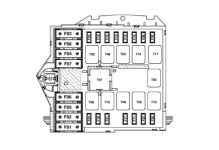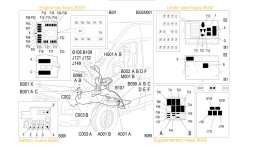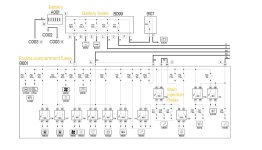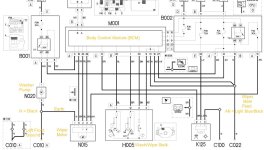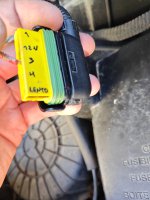Hi, I'm new on this site, and own a ducato motorhome 2007. I need a bit of help. In the engine bay fusebox there is a set of relays. On the left hand side of the fuse box there is a column of 5 relays. Third one from the top is described as 'main relay'. I was passing the mh the other day and heard a buzzing noise. On investigation it turned out to be this relay merrily buzzing away. I have swapped it out for a new one, which buzzed as I put it in, but then stopped, so I assume it is OK. I cannot find anywhere on tinterweb any info about this relay, and what it covers, so, I am hoping that someone here could enlighten me. The van has been stood for 3 months , connected to the electric via the mh charger, to keep the batteries charged, and the habitation heater on very low to keep the inside dry and warm. Please help.
You are using an out of date browser. It may not display this or other websites correctly.
You should upgrade or use an alternative browser.
You should upgrade or use an alternative browser.
Technical Fuses and relays.
- Thread starter PhilM52
- Start date
Currently reading:
Technical Fuses and relays.
Not an expert on motorhomes or electrician, just retired after over 50 years in motortrade.Hi, I'm new on this site, and own a ducato motorhome 2007. I need a bit of help. In the engine bay fusebox there is a set of relays. On the left hand side of the fuse box there is a column of 5 relays. Third one from the top is described as 'main relay'. I was passing the mh the other day and heard a buzzing noise. On investigation it turned out to be this relay merrily buzzing away. I have swapped it out for a new one, which buzzed as I put it in, but then stopped, so I assume it is OK. I cannot find anywhere on tinterweb any info about this relay, and what it covers, so, I am hoping that someone here could enlighten me. The van has been stood for 3 months , connected to the electric via the mh charger, to keep the batteries charged, and the habitation heater on very low to keep the inside dry and warm. Please help.
I would first find out what that relay operates and confirm it is in good order. Any relay "buzzing" is going to wear out quickly as it isn't happy.
I suspect the vehicles charging circuit is reacting to the input from your mh charger and isn't happy.
Would it still charge the circuits in the vehicle as you want, if you connected the power as per normal camper blue site hooker without buzzing, maybe if so, you can fit a "home hook up" as per campsite.
Hi thanks for the reply. I have got the mh plugged in properly through the blue plug connection at home, just as I would at a campsite. I have a dedicated set up for this, with outdoor socket specifically for the job. I run up the engine weekly, and everything was working normally, and appears to be doing so now, with new relay fitted. I just want to find out what the particular relay does. It is exactly the same size as most other relays, and I wouldnormally expect a relay called 'main relay' to be separate and larger in physical size from the others. I can't run up the engine because I have the alarm system disconnected because the thing went u/s at new year (another story), this has the effect of immobilising the engine.Not an expert on motorhomes or electrician, just retired after over 50 years in motortrade.
I would first find out what that relay operates and confirm it is in good order. Any relay "buzzing" is going to wear out quickly as it isn't happy.
I suspect the vehicles charging circuit is reacting to the input from your mh charger and isn't happy.
Would it still charge the circuits in the vehicle as you want, if you connected the power as per normal camper blue site hooker without buzzing, maybe if so, you can fit a "home hook up" as per campsite.
Check the Ducato downloads section it may help, I know they have Iveco Daily manual in pdf form for same engine range, though I don't think Ducato general electrics the same. I had several Iveco Daily, but not campers..Hi thanks for the reply. I have got the mh plugged in properly through the blue plug connection at home, just as I would at a campsite. I have a dedicated set up for this, with outdoor socket specifically for the job. I run up the engine weekly, and everything was working normally, and appears to be doing so now, with new relay fitted. I just want to find out what the particular relay does. It is exactly the same size as most other relays, and I wouldnormally expect a relay called 'main relay' to be separate and larger in physical size from the others. I can't run up the engine because I have the alarm system disconnected because the thing went u/s at new year (another story), this has the effect of immobilising the engine.
You never noticed this fault before when on campsite?
Has it come since alarm/immobiliser issue, generally as you have found aftermarket alarms are not the most reliable.
I assume now alarm disconnected engine runs OK as normal nothing else not working?
No the engine is immobilised, and yes this has come since the alarm problem. The alarm is a Sigma S30, fitted when the chassis cab was built into a motor home in 2007. I now have the new alarm to fit when the weather moderates. £175!! As for reliability, I think 15 years isn't bad! I know the engine will start when the new alarm is fitted, but I just want to know what is affected by the relay going duff. I can't get hold of a paper copy of a workshop manual for it, which may or may not help, or even an electrical diagram. I do know however, that all motorhome electrics are a black art, conjured up by evil wizards employed by the mh companies!Check the Ducato downloads section it may help, I know they have Iveco Daily manual in pdf form for same engine range, though I don't think Ducato general electrics the same. I had several Iveco Daily, but not campers..
You never noticed this fault before when on campsite?
Has it come since alarm/immobiliser issue, generally as you have found aftermarket alarms are not the most reliable.
I assume now alarm disconnected engine runs OK as normal nothing else not working?
Communicator
Prominent member
- Joined
- Aug 3, 2019
- Messages
- 2,898
- Points
- 789
I have only scanned the thread, but my imediate reaction to the initial post is that for "main relay", read "main injection relay". As the name suggests the relay is vital for the engine operation. With ignition off the relay should be de-enengised. Further as the equivalent relay in my 2.8jtd is controlled by the ECU, it unfortunately suggests that you engine ECU may have been damaged, or that a wiring fault has developed.
As you have a faulty alarm/immobiliser system fitted to the vehicle. I suggest that this should be removed or replaced before further diagnosis is attempted. Has your stsrter battery been allowed to completely discharge. I ask because there have been several reports of failed electronics subsequent to such an event. It seems that the electronics do not like slowly decaying supply voltages.
I do not have eLearn for the x250, which includes wiring diagrams and descriptions, but it is available as a download in the downloads section. Perhaps @Anthony489 may be persuaded to assist. However in general, subsequent to the ignition key being operated and electronically recognised by the key code system, the main injection is one of the first items to be operated by the ECU.
Please note that It takes considerable effort to construct these replies, so please post the eventual diagnosis and repair on this thread.
As you have a faulty alarm/immobiliser system fitted to the vehicle. I suggest that this should be removed or replaced before further diagnosis is attempted. Has your stsrter battery been allowed to completely discharge. I ask because there have been several reports of failed electronics subsequent to such an event. It seems that the electronics do not like slowly decaying supply voltages.
I do not have eLearn for the x250, which includes wiring diagrams and descriptions, but it is available as a download in the downloads section. Perhaps @Anthony489 may be persuaded to assist. However in general, subsequent to the ignition key being operated and electronically recognised by the key code system, the main injection is one of the first items to be operated by the ECU.
Please note that It takes considerable effort to construct these replies, so please post the eventual diagnosis and repair on this thread.
- Joined
- Nov 3, 2014
- Messages
- 890
- Points
- 312
Hi
The relay you describe is T09, the main injection relay (See pictures). It supplies power to the Engine Control Unit (ECU), which is in charge of fuel injection.
A relay will only buzz if the coil is being supplied by an intermittent voltage, rather than the correct steady one. So this is a symptom of a fault somewhere else, rather than the relay itself. Needless to say this should be fixed, as the ECU won't take kindly to possibly being fed with a "chopped up" supply from the relay contacts.
As you have a motorhome, there is a chance that under fault conditions the habitation battery can "back feed" into the vehicle electrical system. It should not do this, but it does sometimes happen. The results can be odd and unpredictable, with things trying to power up when they shouldn't. If the leakage is coming via a certain amount of resistance, electronic items may half-start, draw more current, which drops the voltage, which makes them power down again. This rapid stop-start cyclic behaviour may be the cause of the buzz.
The charging circuits added by the motorhome converter have the job of allowing current flow from the alternator to charge the habitation battery, but should not allow any current in the opposite direction. The mains charger is also a potential culprit if it has developed a fault. I suggest you check out the motorhome control panel, and possibly reset it. If you manage to catch the relay making a buzzing noise again, remove the mains supply and see if it stops. If not, disconnect one side of the habitation battery and see if it stops.
Another possibility is that you have some piece of aftermarket electronic or electrical equipment which has connections to both the vehicle power and the habitation power, and this equipment is providing a sneak path between the two.
The relay you describe is T09, the main injection relay (See pictures). It supplies power to the Engine Control Unit (ECU), which is in charge of fuel injection.
A relay will only buzz if the coil is being supplied by an intermittent voltage, rather than the correct steady one. So this is a symptom of a fault somewhere else, rather than the relay itself. Needless to say this should be fixed, as the ECU won't take kindly to possibly being fed with a "chopped up" supply from the relay contacts.
As you have a motorhome, there is a chance that under fault conditions the habitation battery can "back feed" into the vehicle electrical system. It should not do this, but it does sometimes happen. The results can be odd and unpredictable, with things trying to power up when they shouldn't. If the leakage is coming via a certain amount of resistance, electronic items may half-start, draw more current, which drops the voltage, which makes them power down again. This rapid stop-start cyclic behaviour may be the cause of the buzz.
The charging circuits added by the motorhome converter have the job of allowing current flow from the alternator to charge the habitation battery, but should not allow any current in the opposite direction. The mains charger is also a potential culprit if it has developed a fault. I suggest you check out the motorhome control panel, and possibly reset it. If you manage to catch the relay making a buzzing noise again, remove the mains supply and see if it stops. If not, disconnect one side of the habitation battery and see if it stops.
Another possibility is that you have some piece of aftermarket electronic or electrical equipment which has connections to both the vehicle power and the habitation power, and this equipment is providing a sneak path between the two.
Attachments
Hi good reply, thanks. I can only say that the relay is permanently live, or was when I tested it. I have an auto electrician coming Friday to fit the new alarm, also sort the passenger door window which has taken to going up and down when it feels like it. Oh, and to sort some of the habitation lights that have decided not to work, I have spent many hours trying to sort the habitation lights, to no avail. The battery has been kept topped up since the van was last parked up, by the solar panel, and/or by the charger. I will indeed post the diagnosis, should this become apparent. I am grateful to all respondents.I have only scanned the thread, but my imediate reaction to the initial post is that for "main relay", read "main injection relay". As the name suggests the relay is vital for the engine operation. With ignition off the relay should be de-enengised. Further as the equivalent relay in my 2.8jtd is controlled by the ECU, it unfortunately suggests that you engine ECU may have been damaged, or that a wiring fault has developed.
As you have a faulty alarm/immobiliser system fitted to the vehicle. I suggest that this should be removed or replaced before further diagnosis is attempted. Has your stsrter battery been allowed to completely discharge. I ask because there have been several reports of failed electronics subsequent to such an event. It seems that the electronics do not like slowly decaying supply voltages.
I do not have eLearn for the x250, which includes wiring diagrams and descriptions, but it is available as a download in the downloads section. Perhaps @Anthony489 may be persuaded to assist. However in general, subsequent to the ignition key being operated and electronically recognised by the key code system, the main injection is one of the first items to be operated by the ECU.
Please note that It takes considerable effort to construct these replies, so please post the eventual diagnosis and repair on this thread.
Hi again. My mobile Auto electrician has been and sorted my motorhome. He fitted and tested the replacement alarm, fixed the window that had a life of its own, (dirty contacts in the drivers' side window buttons) and sorted the lights that weren't working. (Broken contact due to vibration). Then he looked at the relay I have been stressing about. Turns out that it controls stage 2 of the cooling fans, and that's all. He got the information from Haynes online Fiat Ducato 'Autofix' app. I have now downloaded it for myself. £26 and I think it's going to be worth every penny!!Hi good reply, thanks. I can only say that the relay is permanently live, or was when I tested it. I have an auto electrician coming Friday to fit the new alarm, also sort the passenger door window which has taken to going up and down when it feels like it. Oh, and to sort some of the habitation lights that have decided not to work, I have spent many hours trying to sort the habitation lights, to no avail. The battery has been kept topped up since the van was last parked up, by the solar panel, and/or by the charger. I will indeed post the diagnosis, should this become apparent. I am grateful to all respondents.
The Panda Nut
Nutty about Pandas Infected by Panda virus and OPD
Great post!Hi
The relay you describe is T09, the main injection relay (See pictures). It supplies power to the Engine Control Unit (ECU), which is in charge of fuel injection.
A relay will only buzz if the coil is being supplied by an intermittent voltage, rather than the correct steady one. So this is a symptom of a fault somewhere else, rather than the relay itself. Needless to say this should be fixed, as the ECU won't take kindly to possibly being fed with a "chopped up" supply from the relay contacts.
As you have a motorhome, there is a chance that under fault conditions the habitation battery can "back feed" into the vehicle electrical system. It should not do this, but it does sometimes happen. The results can be odd and unpredictable, with things trying to power up when they shouldn't. If the leakage is coming via a certain amount of resistance, electronic items may half-start, draw more current, which drops the voltage, which makes them power down again. This rapid stop-start cyclic behaviour may be the cause of the buzz.
The charging circuits added by the motorhome converter have the job of allowing current flow from the alternator to charge the habitation battery, but should not allow any current in the opposite direction. The mains charger is also a potential culprit if it has developed a fault. I suggest you check out the motorhome control panel, and possibly reset it. If you manage to catch the relay making a buzzing noise again, remove the mains supply and see if it stops. If not, disconnect one side of the habitation battery and see if it stops.
Another possibility is that you have some piece of aftermarket electronic or electrical equipment which has connections to both the vehicle power and the habitation power, and this equipment is providing a sneak path between the two.
Thanks for your reply, very detailed. The auto electrician that came out yesterday said it was the cooling fans! However, the relay has been chang3d, all other jobs done, including putting the replacement alarm in and testing it. Everything works as it should, an hours drive down and back up the m6 to get everything hot and working at optimum was successful, and all seems OK, so I am a happy bunny now! Now for a good clean inside and out, ready for its mot and habitation check, and I'll be ready for the race season. (I marshal motorcycle racing up and down the country, BSB, WSBK and local club racing). Thanks for the help folks, we're all sorted now!Great post!
- Joined
- Nov 3, 2014
- Messages
- 890
- Points
- 312
Hi
It's a puzzle that the relay you described drives the engine cooling fans.
Just to complete the story, you describe your van as a 2007. Is it an X244 or an X250 model (which I has assumed from the year). ? The first part of the VIN will tell you.
It's a puzzle that the relay you described drives the engine cooling fans.
Just to complete the story, you describe your van as a 2007. Is it an X244 or an X250 model (which I has assumed from the year). ? The first part of the VIN will tell you.
John Dough
Member
- Joined
- Dec 9, 2011
- Messages
- 73
- Points
- 62
As a matter of interest Anthony can you advise where the charging relay is on the X250 as wantvto fit a B2B system. ThanksHi
It's a puzzle that the relay you described drives the engine cooling fans.
Just to complete the story, you describe your van as a 2007. Is it an X244 or an X250 model (which I has assumed from the year). ? The first part of the VIN will tell you.
Hello, tryed to search in the download section but was not able to find a relay diagram.I have only scanned the thread, but my imediate reaction to the initial post is that for "main relay", read "main injection relay". As the name suggests the relay is vital for the engine operation. With ignition off the relay should be de-enengised. Further as the equivalent relay in my 2.8jtd is controlled by the ECU, it unfortunately suggests that you engine ECU may have been damaged, or that a wiring fault has developed.
As you have a faulty alarm/immobiliser system fitted to the vehicle. I suggest that this should be removed or replaced before further diagnosis is attempted. Has your stsrter battery been allowed to completely discharge. I ask because there have been several reports of failed electronics subsequent to such an event. It seems that the electronics do not like slowly decaying supply voltages.
I do not have eLearn for the x250, which includes wiring diagrams and descriptions, but it is available as a download in the downloads section. Perhaps @Anthony489 may be persuaded to assist. However in general, subsequent to the ignition key being operated and electronically recognised by the key code system, the main injection is one of the first items to be operated by the ECU.
Please note that It takes considerable effort to construct these replies, so please post the eventual diagnosis and repair on this thread.
Can someone share? I need to locate a ducto 2009 wiper relay (max speed not working).
Thank you all
- Joined
- Nov 3, 2014
- Messages
- 890
- Points
- 312
Hi manmacedo
As low speed is working, the main 12 volt supply through Fuse F43 and Relay T12 is OK
There are two other wiper relays hidden inside the wiper motor casing. They are energised by the body control module (BCM). One relay turns the wipers on, the other relay changes the speed from high to low.
See the attached diagrams, one is from eLearn, the other (wiper internal) was drawn by me.
The wiper motor wires are as follows
Pin 1 Black Ground
Pin 2 Light Blue / Black +12 volt supply via Fuse F43 and Relay T12 (In Fuse and Junctuon unit under dashboard)
Pin 3 White/Black Control input from BCM, Low for high speed
Pin 4 White/Blue Control input from BCM, Low for wipers on
Pin 5 White/Green Control output to BCM, Low for park
If you have no high speed, check that the voltage on Pin 3 changes between about 12 volts and 0 volts when you operate the stalk switch from Low to High
If the voltage changes, the problem may be inside the motor
If the voltage does not change, the problem may be in the BCM or the wiper stalk speed switch
The stalk switch changes its resistance for different settings. The resistance is measured by the BCM so that it "knows" what has been selected. This arrangement reduces the number of interconnecting wires.
As low speed is working, the main 12 volt supply through Fuse F43 and Relay T12 is OK
There are two other wiper relays hidden inside the wiper motor casing. They are energised by the body control module (BCM). One relay turns the wipers on, the other relay changes the speed from high to low.
See the attached diagrams, one is from eLearn, the other (wiper internal) was drawn by me.
The wiper motor wires are as follows
Pin 1 Black Ground
Pin 2 Light Blue / Black +12 volt supply via Fuse F43 and Relay T12 (In Fuse and Junctuon unit under dashboard)
Pin 3 White/Black Control input from BCM, Low for high speed
Pin 4 White/Blue Control input from BCM, Low for wipers on
Pin 5 White/Green Control output to BCM, Low for park
If you have no high speed, check that the voltage on Pin 3 changes between about 12 volts and 0 volts when you operate the stalk switch from Low to High
If the voltage changes, the problem may be inside the motor
If the voltage does not change, the problem may be in the BCM or the wiper stalk speed switch
The stalk switch changes its resistance for different settings. The resistance is measured by the BCM so that it "knows" what has been selected. This arrangement reduces the number of interconnecting wires.
Attachments
- Joined
- Nov 3, 2014
- Messages
- 890
- Points
- 312
Hi
You must measure these voltages with the wiper still connected in circuit. If access is too difficult, I recommend that you attach (tee in) some temporary thin insulated wires ( about 1 metre long ) so that you can probe them with your multimeter.
You must measure these voltages with the wiper still connected in circuit. If access is too difficult, I recommend that you attach (tee in) some temporary thin insulated wires ( about 1 metre long ) so that you can probe them with your multimeter.
Thank you,
Just tested as you proposed and got:
-when stalk switch in resting position and key out I get low voltage, and I get 12v if key on.
-when stalk switch moved anti clock wise I get low negative voltage.
-when stalk switch moved clock wise (wiper low speed) I get 12v.
-when stalk switch moved clock wise one more step (wiper intermittent) I elso get 12v.
-when stalk switch moved clock wise all the way (fast wipe speed) I get low negative voltage.
Are this the readings that I was suppose to get if the problem is in the wiper motor?
And again, thanks a lot for your tips.
Just tested as you proposed and got:
-when stalk switch in resting position and key out I get low voltage, and I get 12v if key on.
-when stalk switch moved anti clock wise I get low negative voltage.
-when stalk switch moved clock wise (wiper low speed) I get 12v.
-when stalk switch moved clock wise one more step (wiper intermittent) I elso get 12v.
-when stalk switch moved clock wise all the way (fast wipe speed) I get low negative voltage.
Are this the readings that I was suppose to get if the problem is in the wiper motor?
And again, thanks a lot for your tips.
Similar threads
- Replies
- 1
- Views
- 205
- Replies
- 13
- Views
- 344


